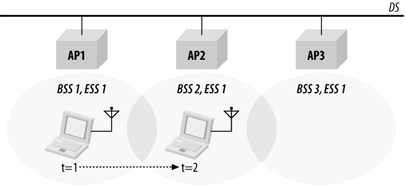Mobility Support
Mobility is the usually the primary motivation for deploying an 802.11 network. Transmitting data frames while the station is moving will do for data communications what mobile telephony did for voice.
802.11 provides mobility between basic service areas at the link layer. However, it is not aware of anything that happens above the link layer. When designing deploying 802.11, networks engineers must take care so that the seamless transition at the radio layer is also supported at the network protocol layer that the station IP address can be preserved. As far as 802.11 is concerned, there are three types of transitions between access points:
No transition
When stations do not move out of their current access point's service area, no transition is necessary. This state occurs because the station is not moving or it is moving within the basic service area of its current access point. (Arguably, this isn't a transition so much as the absence of a transition, but it is defined in the specification.)
BSS transition
Stations continuously monitor the signal strength and quality from all access points administratively assigned to cover an extended service area. Within an extended service area, 802.11 provides MAC layer mobility. Stations attached to the distribution system can send out frames addressed to the MAC address of a mobile station and let the access points handle the final hop to the mobile station. Distribution system stations do not need to be aware of a mobile station's location as long as it is within the same extended service area.
Figure below illustrates a BSS transition. The three access points in the picture are all assigned to the same ESS. At the outset, denoted by t=1, the laptop with an 802.11 network card is sitting within AP1's basic service area and is associated with AP1. When the laptop moves out of AP1's basic service area and into AP2's at t=2, a BSS transition occurs. The mobile station uses the reassociation service to associate with AP2, which then starts sending frames to the mobile station.
BSS transitions require the cooperation of access points. In this scenario, AP2 needs to inform AP1 that the mobile station is now associated with AP2. 802.11 does not specify the details of the communications between access points during BSS transitions.
Note that even though two access points are members of the same extended set, they may nonetheless be connected by a router, which is a layer 3 boundary. In such a scenario, there is no way to guarantee seamless connectivity using 802.11 protocols only.
ESS transition
An ESS transition refers to the movement from one ESS to a second distinct ESS. 802.11 does not support this type of transition, except to allow the station to associate with an access point in the second ESS once it leaves the first. Higher-layer connections are almost guaranteed to be interrupted. It would be fair to say that 802.11 supports ESS transitions only to the extent that it is relatively easy to attempt associating with an access point in the new extended service area. Maintaining higher-level connections requires support from the protocol suites in question. In the case of TCP/ IP, Mobile IP is required to seamlessly support an ESS transition.
In this tutorial:
- 802.11 Networks
- IEEE 802 Network Technology Family Tree
- Nomenclature and Design
- Types of Networks
- Independent networks
- Infrastructure networks
- Extended service areas
- Multi-BSS environments: "virtual APs"
- Robust security networks (RSNs)
- The Distribution System, Revisited
- Interaccess point communication as part of the distribution system
- Wireless bridges and the distribution system
- Network Boundaries
- 802.11 Network Operations
- Network Services
- Station services
- Distribution system services
- Confidentiality and access control
- Spectrum management services
- Mobility Support
- Designing Networks for Mobility

